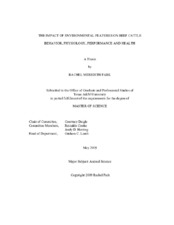| dc.description.abstract | Two separate experiments were conducted to further understand beef cattle welfare. The first experiment (e.g. systematic review) sought to answer the question “How do housing facility features impact the status of animal welfare of beef cattle?” From 1,147 citations, 40 studies were included that evaluated the impact of a feature of beef cattle housing on welfare. Housing features were categorized by floor type, space allowance, shade availability, and inclusion of enrichment devices or ventilation features. The second experiment evaluated the impact of environmental enrichment (EE) on cattle stress physiology, health, productivity and behavior. The EE consisted of an Lshaped brush structure mounted to the fence line furthest from the feed bunk. Fifty-four crossbred steers were randomly assigned to one of two treatments 1) No enrichment (CON) or 2) Enrichment (BRUSH). Hair coat shed scores were recorded upon arrival at the feedlot (d -55) and prior to shipment of first weight block (d 161) for slaughter using an objective scoring system. Body weights and hair samples for cortisol extraction were obtained at 35-d intervals throughout the duration of the study. Average daily gain, G:F and weekly DMI were calculated. Upon slaughter, carcass data were collected. Decoded video recordings measured the frequency and duration of behaviors for 9.5 hours on d - 2, -1, 0, 1, 2, 4, 8, 16, 32 and 64 relative to brush installation using both continuous and scan sampling. Impact of day, treatment and their interactions were evaluated using PROC MIXED in SAS. Treatment did not impact steer stress physiology, feed efficiency or carcass traits (P > 0.05). BRUSH cattle performed fewer headbutts (P = 0.006), engaged in bar licking less frequently (P = 0.009) and for a shorter duration (P = 0.035) compared to CON cattle. For BRUSH cattle, frequency and duration of brush usage changed over time peaking on d 0 (P < 0.001). BRUSH cattle performed fewer stereotypic and aggressive behaviors and cattle did not habituate to the brush over time. Presence of a cattle brush did not negatively impact production or physiology of the animals. A cattle brush would be beneficial to feedlot cattle welfare. | en |


